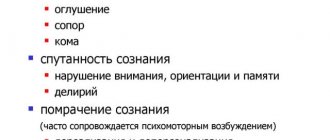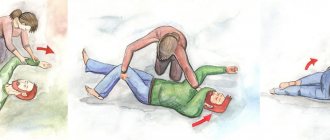Sometimes states arise when clear consciousness, due to the action of certain factors, becomes clouded and narrowed. In such a twilight state of consciousness, a person can commit socially dangerous actions and cause irreparable harm to objects and people. This disorder of consciousness is difficult because it arises and disappears suddenly, without any prerequisites or consequences for the person himself.
Twilight stupefaction - what is it and how does it manifest?
A twilight state of consciousness is a mental state with deep disorientation, limitation of consciousness on certain objects or persons, accompanied by psychomotor restlessness and aggression.
An episode of twilight disorder of consciousness is subsequently replaced by complete amnesia; the person cannot remember how he behaved, what happened around him during the narrowing of consciousness.
In clinical practice, there are often cases when a person unknowingly leaves for another city or region. He subsequently describes his state as follows: “Sitting on the bus, I seemed to think or close my eyes for a few seconds... I didn’t understand how I ended up in a place unfamiliar to me. I asked a passerby, it turned out I was in another city...” However, not in all cases this violation is harmless; a person can unknowingly seriously injure or kill, and with frantic cruelty.
Twilight disorder of consciousness refers to disorders of higher mental processes. With the help of consciousness, a person learns about the world around him, himself, and adapts to changing environmental conditions.
Being in a clear consciousness, a person easily relates himself and the surrounding reality, soberly assesses his capabilities. In this case, they say that he is correctly oriented in location, time, surrounding situation and his own personality.
Main features
4 main signs of impaired consciousness:
- detachment from reality: a person does not understand what is happening around him, attention is narrowed to one or several objects, he is not interested in people and external circumstances,
- allo- and autopsychic disorientation of varying degrees of severity: impaired perception of place, time, one’s personality,
- thinking disorder: a person is unable to clearly express his thoughts and answer questions asked, speech is confused, incoherent,
- memory impairment: after the state is normalized, a fragment during which consciousness was narrowed falls out of memory.
Twilight disorder of consciousness is associated not only with disorientation, but also with various automatisms - stereotypical, sharp, repetitive movements, sometimes even of a professional nature: during a twilight disorder, a carpenter makes movements as if working on a machine, an operator continues to work on an assembly line, and a bus conductor – sell tickets to imaginary passengers.
As a rule, most often a person is in motor agitation, moves chaotically, movements are not purposeful and destructive in nature.
There are several types of mental automatisms: trance and fugue. During trance, ambulatory automatisms have a complex structure; movements from the outside seem quite consistent. However, these actions were not planned by the person himself; they are ineffective.
Most often, patients with this variant of twilight narrowing of consciousness are prone to moving, traveling in transport, and unknowingly leaving for another city or region. Outwardly, one notices a drowsy appearance and a certain confused detachment from what is happening. The trance can last from several minutes to several days.
A fugue is a sudden change of state with the need to escape or run. Movements are also aimless and unrelated to the environment. The fugue is short-lived, only a few minutes.
A narrowing of consciousness occurs suddenly against the background of emotional stress, anger, rage, fear. Both hallucinatory and illusory experiences at the height of affect are characteristic.
Twilight disorder can occur not only during the day. Disturbances that occur at night are called somnambulism or sleepwalking.
Prevention options
Prevention consists of primary and secondary measures. Primary is carried out before the onset of the disease, and secondary is aimed at preventing relapses.
Primary prevention is based on compliance with the rules of a healthy lifestyle and general medical recommendations:
- Activities associated with an increased risk of traumatic brain injury should be avoided;
- when visiting areas endemic for neuroinfections (tick-borne encephalitis, etc.), routine vaccination against them should be carried out;
- nutrition should be rational and contain the required amount of proteins, vitamins and microelements;
- it is necessary to eliminate bad habits and addictions: smoking, drinking alcohol and drug addiction;
- You should exercise regularly, etc.
If there is a history of mental or organic diseases with brain damage, as well as cases of twilight disorder, a person needs secondary prevention:
- stressful situations are excluded;
- the prescribed therapy for the treatment of the primary disease is compulsorily followed (in no case should you change medications, their dosage, or even stop taking them);
- If any disturbances in perception occur, immediately seek medical help.
The patient's loved ones play an important role in preventing relapses. They should create a favorable atmosphere in their home and work environment. Conflict situations must be excluded.
How does a disorder of consciousness occur?
Consciousness is disrupted sharply and suddenly, without any prerequisites. The condition returns to normal just as quickly, leaving no consequences on the person’s well-being.
With the dysphoric version of twilight disorder of consciousness, the patient looks detached from the world around him, his facial expression is angry, anxious. Productive contact with a person in this state is impossible. The behavior does not correspond to what is happening. Criticism is completely lost.
With hallucinatory twilight disturbance of consciousness, bright, imaginative, threatening hallucinations occur. More often, these may be auditory or visual hallucinatory phenomena that cause aggressive or defensive behavior in a person.
Destructive behavior can be directed at objects or even people. Stereotypical actions are carried out with particular force and cruelty, for example, while in a twilight state of consciousness, a person can inflict 30 or more stab wounds.
In delusional twilight disorder, behavior is determined by a delusional interpretation of what is happening. More often, delusions of persecution occur; the patient either takes a defensive position or seeks to escape from imaginary ill-wishers.
What diseases can it occur in?
Twilight syndrome can occur in various mental illnesses and pose a significant danger to society.
Twilight states can be functional (affective, hysterical, psychogenic) and organic (epileptic or epileptiform syndrome).
Twilight syndrome is observed in hysterical psychoses. The occurrence in this case is associated with a traumatic situation. Consciousness narrows at the height of significant experiences and violent emotional reactions. In behavior one can note theatricality, infantilism, pseudo-dementia. It is possible to distinguish from twilight states of organic origin by EEG: changes in hysterical psychoses are not detected.
With schizophrenia, delusional disorientation may occur: at the height of delusional experiences, a person can be completely cut off from the outside world, immersed in his own painful reality. You lose orientation in time, place, and sometimes even in your own personality. After emerging from the twilight disturbance of consciousness, islands of recollection may remain in the memory, which are subsequently interpreted deliriously, and residual delusion arises.
In case of amnestic disorientation, which occurs in severe head injuries and dementia, the narrowing of consciousness is associated with severe memory impairment.
In a severe depressive state against the background of decreased mood, volitional and critical components, apathetic disorientation with detachment from the outside world may occur.
Most often, twilight disorder of consciousness occurs with epilepsy and may follow a seizure or be its equivalent. Sometimes an attack of impaired consciousness is preceded by a so-called aura, when the patient feels the approach of an attack, is bothered by a headache, photophobia, increased sense of smell, etc. A person may notice sleep disturbances, sudden mood swings towards angry-angry and dysphoric affect.
There is an oneiric variant of twilight disorder of consciousness. It is characterized by an abundance of vivid, fantastic hallucinations and catatonic manifestations.
There are twilight episodic disturbances of consciousness: simple twilight, impulsive, hallucinatory, expansive, psychomotor. The clinical picture reveals a period of precursors with insomnia, asthenia, and fatigue. After the twilight contraction in this case, a long, deep sleep occurs.
Diagnostics
The diagnosis of twilight disorder of consciousness is made on the basis of clinical data and the patient’s behavior. Certain difficulties in forensic psychiatric examination are presented by the diagnosis of oriented twilight disorders, in which traces of orientation are preserved (recognition of loved ones, particles of self-awareness), and there are no delusions and hallucinations.
Patients give the impression of people who are not completely awake (unsteady, shaky gait, slurred speech).
In case of twilight syndrome of organic origin, a more complete examination is necessary: MRI of the brain, EEG, consultation with a neurologist. When diagnosing epilepsy - consultation with an epileptologist and EEG with stress tests and dynamics.
Stun
Stunning is a pathology that has a distinctive feature - mental impoverishment. The patient's behavior becomes more withdrawn, with slow coordination of movements, detached, in a state of prostration. He does not clearly understand the speech in the dialogue and answers inaccurately. But this stage of the disease does not have obvious mental disorders. The person does not experience aggression, there are no hallucinations, high levels of confusion, or insomnia. If left untreated, this stage can become more complex, causing the person to stop speaking, then stop moving and become comatose. The initial stage of stunning is called nullification.
Are disorders of consciousness treatable?
Dysphoric, hallucinatory and delusional variants of twilight disorder of consciousness pose a public danger. A person can commit crimes with extreme cruelty.
First aid for narrowing of consciousness is to isolate the patient to exclude the possibility of self-harm or harm to others until the ambulance arrives. If possible, the limbs should be immobilized, and diazepam should be administered to relieve psychomotor agitation.
The patient is hospitalized in a psychiatric ward, where therapy with tranquilizers and antipsychotics continues until the pathological condition emerges. The cause of the narrowing of consciousness is being clarified. If this is a pathology of organic origin, the underlying disease is treated under the supervision of a neurologist.
Therapeutic principles
Antipsychotics are used as part of drug therapy. The drugs have a sedative effect, eliminate hallucinations, psychomotor agitation and other symptoms. Psychiatrists often use Aminazine and Tizercin, which have minimal side effects. If, while using antipsychotics, there is a decrease in blood pressure, Cordiamine is prescribed.
To relieve agitation, therapy is carried out according to the following scheme:
- Intramuscular administration of Haloperidol, Olanzapine, Diazepam or Aminazine. Dosages of medications are selected individually.
- With severe psychomotor agitation, intramuscular use of Midazolam at a dose of 5-10 mg is possible.
- It is possible to use anesthetics: Hexobarbital or Propofol. The drugs are prescribed intramuscularly or intravenously.
- After the excitement is removed, the form of the drugs is changed from injection to tablet. They are used until the symptoms are completely relieved.
- If the course is prolonged, neuroleptics continue to be used until they are discontinued by a psychiatrist.
In parallel, therapy is carried out for the underlying disease that caused twilight stupefaction:
- For epilepsy, antiepileptic drugs based on valproic acid are used. Patients must take them constantly, since refusal of medications leads to another relapse.
- For the negative consequences of traumatic brain injuries or neuroinfections, nootropics (Piracetam, Phenotropil) and antioxidants (Dihydroquercetin, Tocopherol) are used to improve the functioning of nerve cells and protect them from negative effects. Medicines that improve blood flow in the cerebral vessels - Cerebrolysin, Actovegin, etc. - have a similar effect.
During the acute period of the disorder, the patient requires hospitalization. In a psychiatric hospital, relapse is stopped and constant medical supervision is established. As trance develops, the period of disturbed consciousness may persist for several hours or days. Repeated exacerbations may develop during hospitalization.
Of the non-drug methods, the key in the treatment of twilight disorder is psychotherapy aimed at achieving stable remission and preventing relapses. Patients are offered both individual and group sessions.









